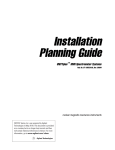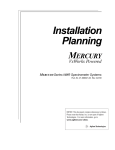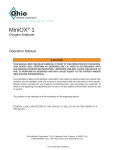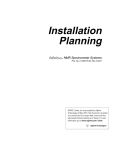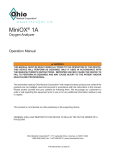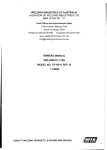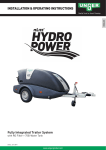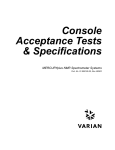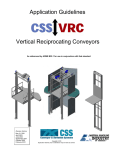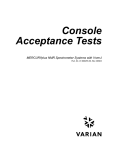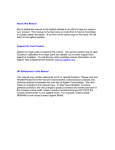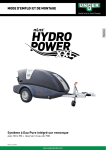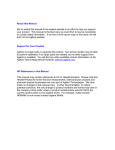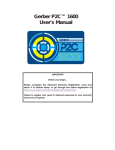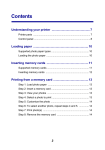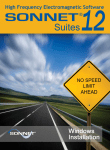Download GEMINI 2000 Installation Planning Guide
Transcript
GEMINI 2000
Installation
Planning Guide
GEMINI 2000 NMR Sprectrometer Systems
Pub. No. 87-192320-00, Rev. A0894
NOTICE: This document contains references to Varian.
Please note that Varian, Inc. is now part of Agilent
Technologies. For more information, go to
www.agilent.com/chem.
GEMINI 2000 Installation Planning Guide
GEMINI 2000 NMR Sprectrometer Systems
Pub. No. 87-192320-00, Rev. A0894
Revision history:
Rev. A0894 – Initial release
Applicability of manual:
GEMINI 2000 NMR spectrometer systems
Technical contributors: Frits Vosman, Mark Stevenson, Dick Kelley
Technical writer: Dan Steele
Technical editor: Jim Welch
Copyright 1994 by Varian, Inc.
3120 Hansen Way, Palo Alto, California 94304
http://www.varianinc.com
All rights reserved. Printed in the United States.
The information in this document has been carefully checked and is believed to be
entirely reliable. However, no responsibility is assumed for inaccuracies. Statements in
this document are not intended to create any warranty, expressed or implied.
Specifications and performance characteristics of the software described in this manual
may be changed at any time without notice. Varian reserves the right to make changes in
any products herein to improve reliability, function, or design. Varian does not assume
any liability arising out of the application or use of any product or circuit described
herein; neither does it convey any license under its patent rights nor the rights of others.
Inclusion in this document does not imply that any particular feature is standard on the
instrument.
GEMINI 2000 is a trademark of Varian, Inc. Sun, Solaris, CDE, Suninstall, SPARC,
SPARCstation, SunCD, and NFS are registered trademarks or trademarks of Sun
Microsystems, Inc. and SPARC International. Oxford is a registered trademark of
Oxford Instruments LTD. Ethernet is a registered trademark of Xerox Corporation. Other
product names in this document are registered trademarks or trademarks of their
respective holders.
Table of Contents
GEMINI 2000 Installation Planning .................................................................................. 7
Safety Precautions ............................................................................................................. 7
Installation Site Requirements ........................................................................................... 7
Accessibility............................................................................................................. 8
Site Size ................................................................................................................... 8
Ceiling Height.......................................................................................................... 9
Maximum Altitude................................................................................................. 11
Structural Strength of Floor ................................................................................... 11
Magnet Weight Distribution—No Antivibration System...................... 11
Magnet Weight Distribution—With Antivibration System................... 11
Antivibration Bolt-Down Requirement ................................................................. 13
Floor Vibration Requirements................................................................................ 13
Magnetic Environment........................................................................................... 13
Safety Hazards of Strong Magnetic Fields ............................................................ 15
Radio-Frequency Environment .............................................................................. 16
Radio-Frequency Emissions from Varian NMR Equipment ................................. 16
Ambient Temperature and Humidity ..................................................................... 16
Ventilation .............................................................................................................. 17
Installation Site Preparation .............................................................................................
Line Voltage Variation ...........................................................................................
Electrical Outlets....................................................................................................
Compressed Air Supply .........................................................................................
Compressed Nitrogen Gas .....................................................................................
Air Conditioning ....................................................................................................
Telephone...............................................................................................................
Magnetic Field Considerations ..............................................................................
Electrostatic Discharges.........................................................................................
18
18
19
19
20
20
21
21
21
Installation Supplies and Equipment ...............................................................................
Liquid Helium Supply ...........................................................................................
Liquid Nitrogen Supply ........................................................................................
Helium Gas Supply ...............................................................................................
Nitrogen Gas Required for Magnet Installation.....................................................
Face Mask and Thermal Gloves.............................................................................
Heat Gun ................................................................................................................
Ladder (non-magnetic)...........................................................................................
Hoist.......................................................................................................................
Cryogenic Equipment Rack (Recommended) .......................................................
21
22
22
23
23
24
24
24
24
24
87-192320-00 A0894
GEMINI 2000 Installation Planning Guide
3
Table of Contents
Electrical Power Surge Protector (Recommended) ............................................... 24
Computer Preparation ......................................................................................................
Magnetic Field Precautions for Computers and Peripherals .................................
Configuring the Sun Computer..............................................................................
Purchasing Software Media...................................................................................
Installing Sun and VNMR Software......................................................................
Computer Preparation Checklist............................................................................
Peripherals Available .............................................................................................
Collecting System and Network Information ........................................................
25
25
25
25
25
26
27
27
System Configuration Type...................................................................
Selecting a Hostname............................................................................
Obtaining the IP Address ......................................................................
Selecting a Subnet Mask.......................................................................
Selecting the Name Service Type .........................................................
Entering the Hostname and IP Address of the Name Server ................
Domain Name .......................................................................................
Setting the Time Zone...........................................................................
Disk Layout...........................................................................................
Pre-Installation Worksheet.....................................................................................
27
27
28
28
28
28
28
28
29
29
Receiving Preparations .................................................................................................... 30
Postdelivery Instructions ................................................................................................. 31
Inspecting for Shipping Damage ........................................................................... 31
Moving the System ................................................................................................ 31
Appendix A. Installation Checklists ................................................................................ 33
Predelivery Checklist............................................................................................. 33
Postdelivery Checklist ........................................................................................... 33
Appendix B. Stray Field Plots ......................................................................................... 35
Appendix C. Posting Requirements for Magnetic Field Warning Signs .........................
Warning Signs........................................................................................................
Public Access Areas ..............................................................................................
Safety Training ......................................................................................................
37
37
38
38
Appendix D. Typical Room Layouts ...............................................................................
Minimum Possible Room Size—200- and 300-MHz............................................
Recommended Room Layout—200- and 300-MHz .............................................
Recommended Layout with SMS Autosampler—200- and 300-MHz .................
Recommended Room Layout—400-MHz.............................................................
Recommended Room Layout with SMS Autosampler—400-MHz......................
GEMINI 2000 Illustrations for Room Layout .......................................................
Blank Grid for Room Layout.................................................................................
39
40
42
43
44
45
46
47
Appendix E. Peripheral Compatibility ........................................................................... 49
Explanation of Status Listing ................................................................................ 49
Printer and Plotter Compatibility........................................................................... 49
Hewlett-Packard ThinkJet (HP2225D) ................................................. 49
Hewlett-Packard QuietJet (HP2227A).................................................. 49
Hewlett-Packard DeskJet ...................................................................... 49
4
GEMINI 2000 Installation Planning Guide
87-192320-00 A0894
Table of Contents
Hewlett-Packard LaserJet III (HP33449A) ........................................... 49
Hewlett-Packard LaserJet 4................................................................... 49
IBM/Lexmark Color Jetprinter (PS 4079) ............................................ 49
Hewlett-Packard HP7475 (HP7475A) .................................................. 50
Hewlett-Packard HP7550 (HP7550B)................................................... 50
Hewlett-Packard DraftPro (HP7570A) ................................................. 50
Computer Compatibility ........................................................................................ 50
Sun SPARCsystem 600 MP series ........................................................ 50
Index ................................................................................................................................ 51
List of Figures
Figure 1. Plan views of floor contact points of magnet stands ........................................ 12
Figure 2. Platform antivibration system leg placements and sizes .................................. 12
Figure 3. Magnet leg antivibration system leg placement and sizes................................ 12
Figure 4. Stray field plots for 200-MHz magnets ............................................................ 35
Figure 5. Stray field plots for 300-MHz magnets ........................................................... 35
Figure 6. Stray field plots for 400-MHz magnets ........................................................... 36
87-192320-00 A0894
GEMINI 2000 Installation Planning Guide
5
Table of Contents
List of Tables
Table 1. Magnet dimensions and weights .......................................................................... 9
Table 2. Cabinet and optional components dimensions and weights ............................... 10
Table 3. Ceiling height minimum .................................................................................... 10
Table 4. Interaction between common objects and a magnetic field ............................... 14
Table 5. Stray field data for Oxford magnets ................................................................... 15
Table 6. Results of rf emissions tests on Varian NMR equipment .................................. 17
Table 7. IEEE/ANSI C95.1-1991 standard for rf radiation levels ................................... 17
Table 8. Ambient temperature and relative humidity ....................................................... 18
Table 9. Liquid helium displacement for room ventilation considerations ...................... 18
Table 10. Compressed air supply source .......................................................................... 20
Table 11. Initial on-site and short-notice liquid helium supplies ..................................... 22
Table 12. Initial on-site liquid nitrogen supply ................................................................ 22
6
GEMINI 2000 Installation Planning Guide
87-192320-00 A0894
GEMINI 2000 Installation Planning
This guide is intended to assist the customer in selecting and preparing a site to install
a Varian GEMINI 2000 Series NMR superconducting spectrometer system. By
following the information presented, and by using the predelivery and postdelivery
checklists provided in “Appendix A. Installation Checklists” on page 33, a smooth
transition from delivery to installation will be made.
Keep in mind that Varian’s delivery responsibility ends at Varian’s factory shipping
dock or at the customer’s receiving dock, depending upon the type of insurance
obtained by the customer. In either case, the customer must provide a moving crew to
move the shipping crates holding the system from the delivery truck (or storage
location) to the installation site.
Certain supplies not provided by Varian, such as helium and nitrogen supplies, must be
obtained by the customer before the Varian installation engineer can start the
installation. This guide lists and describes these supplies in detail.
We at Varian will make every effort to ensure that the ownership of your new NMR
spectrometer is a lasting and pleasurable experience. If you have any questions, do not
hesitate to call your local sales representative or to contact us at the following location:
Varian, Inc., NMR Systems
Customer Support Group
3120 Hansen Way, MS D-421
Palo Alto, CA 94304-1030
Telephone: 1-800-356-4437
Safety Precautions
Throughout this guide are important warnings and cautions that you should read and
follow carefully. These safety precautions have the following format and meaning:
WARNING
Warnings are used when failure to observe instructions or precautions
could result in injury or death to humans or animals, or significant
property damage.
CAUTION
Cautions are used when failure to observe instructions could result in
permanent damage to equipment or loss of data.
Installation Site Requirements
Check the “SHIP BY” date on the Varian Order Acknowledgment form. Use this date
as a target for completing installation preparations. If you anticipate any delays in site
readiness and need to delay shipment, notify the factory at least 90 days in advance.
87-192320-00 A0894
GEMINI 2000 Installation Planning Guide
7
Installation Site Requirements
Factors to consider when selecting the installation site include:
• Accessibility to the delivery location
• Site size and ceiling height
• Floor rigidity and structural strength
• Magnetic and radio frequency environment
• Ambient temperature and humidity
• Air ventilation
Each item is described further below.
Accessibility
The installation site must be accessible from the delivery location, with adequate
clearance for system crates and moving equipment throughout the access route.
Table 1 and Table 2 contain system dimensions and weights for calculating vertical,
horizontal, and turning clearances, as well as evaluating the structural strength of
passageways. Moving the larger crates of the system will require a forklift or hydraulic
pallet mover, which must be considered when calculating accessibility.
For an installation site at a different level from the delivery location, be sure that the
lifting equipment (such as an elevator) is capable of handling the combined weight and
size of the shipping crates and the moving equipment.
If it is not possible to gain access to the installation site unless the system is uncrated,
contact a Varian service representative for further instructions. Do not uncrate the
system except with direct instructions from an authorized service representative.
The site must also provide adequate access for the routine delivery of supply dewars
containing liquid helium and nitrogen.
Site Size
The site must be large enough to allow free access to all sides of the system and magnet
for operation, maintenance, and cryogenic service. Table 1 and Table 2 contain the
dimensions of the system components, and “Appendix D. Typical Room Layouts” on
page 39 contains floor plans recommended for the NMR laboratory area or room.
These plans are suggestions and not specifications.
All cabinets are mounted on casters for easy movement, which allows the system to be
placed in a location as small as that illustrated in the “Minimum Size Laboratory Plan
Possible” in Appendix D, as long as there is sufficient space for the cabinets to be
moved to gain access on all sides. For comfort and convenience, however, and to
provide space for an automatic sample changer or other options, the larger layouts
shown in Appendix D are highly recommended. The minimum dimensions do not
include compensation for external magnetic and rf interference that may be present.
Each individual site must be analyzed to ensure optimum system performance.
8
GEMINI 2000 Installation Planning Guide
87-192320-00 A0894
Installation Site Requirements
Table 1. Magnet dimensions and weights
Magnets as shipped with crate and pallet*
Magnet type**
(MHz/mm)
Height
cm (in.)
Width
cm (in.)
Depth
cm (in.)
Weight
kg (lb)
200/54
120 (47)
79 (31)
88 (35)
132 (290)
200/54 LH235
200 (80)
95 (37.25)
95 (37.25)
468 (1030)
200/54 LH365
200 (80)
95 (37.25)
95 (37.25)
468 (1030)
300/54
120 (47)
79 (31)
88 (35)
142 (313)
300/54 LH235
200 (80)
95 (37.25)
95 (37.25)
468 (1030)
300/54 LH365
200 (80)
95 (37.25)
95 (37.25)
468 (1030)
400/54
200 (80)
95 (37.25)
95 (37.25)
468 (1030)
400/54 LH365
200 (800)
95 (37.25)
95 (37.25)
468 (1030)
Magnets unpacked with crate and pallet removed and stand or legs attached*
Magnet type**
(MHz/mm)
Height
cm (in.)
Width
cm (in.)
Depth
cm (in.)
Operational
Weight
kg (lb)
200/54
158 (62)
76 (30)
66 (26)
136 (300)
200/54 LH235
228 (90)
78 (31)
78 (31)
268 (591)
200/54 LH365
235 (92.5)
78 (31)
78 (31)
278 (613)
300/54
168 (66)
69 (27)
69 (27)
152 (335)
300/54 LH235
235 (92.5)
78 (31)
78 (31)
278 (613)
300/54 LH365
235 (92.5)
78 (31)
78 (31)
278 (613)
400/54
235 (92.5)
69 (27)
69 (27)
400 (880)
400/54 LH365
235 (92.5)
78 (31)
78 (31)
380 (838)
* Dimensions and weights are approximate and subject to change. Height dimensions do not
include optional accessories such as a siphon or plow-out tube.
** Long-hold magnets are designated by “LH” and a number that represents hold time in days.
Ceiling Height
The ceiling must provide sufficient headroom to insert the liquid helium transfer tube
into the magnet dewar and the storage dewar. The height of the ceiling (or that part of
the ceiling located directly above the magnet) without obstructions such as lighting and
heating ducts must be equal to or greater than the minimum heights in Table 3.
These ceiling minimums allow enough headroom to insert the standard helium flutter
tube and refill transfer tubes into the magnet dewar. They also allow use of the standard
power stick for running up the magnet field. If one of the larger capacity liquid helium
storage dewars is used with the magnet, however, additional ceiling clearance may be
87-192320-00 A0894
GEMINI 2000 Installation Planning Guide
9
Installation Site Requirements
Table 2. Cabinet and optional components dimensions and weights
Components as shipped with carton and pallet*
Component
Electronics
Cabinet
Height
cm (in.)
Width
cm (in.)
Depth
cm (in.)
Weight
kg (lb)
129.5 (51)
73.6 (29)
102 (40)
261 (575)
Autosampler
Work Table
23 (50)
31 (12)
198 (78)
91 (36)
53 (117)
Components unpacked, carton and pallet removed*
Electronics
Cabinet
115.6 (45.5)
55.9 (22)
83.2 (32.75)
227 (500)
Autosampler
71 (28)
34.3 (13.5)
34.3 (13.5)
17 (38)
Work Table
67 (26.5)
183 (72)
76 (30)
48 (107)
* Dimensions and weights are approximate and subject to change.
Table 3. Ceiling height minimum
10
Magnet Type
MHz/mm
Ceiling Minimum
cm (in.)
With Optional Helium Level
Sensor
cm (in.)
200/54
247 (97.4)
Not Applicable
200/54 LH235
314 (124)
365 (144)
200/54 LH365
321 (126.5)
365 (144)
300/54
252 (99)
Not Applicable
300/54 LH235
321 (126.5)
365 (144)
300/54 LH365
321 (126.5)
365 (144)
400/54
321 (126.5)
365 (144)
400/54 LH365
321 (126.5)
365 (144)
GEMINI 2000 Installation Planning Guide
87-192320-00 A0894
Installation Site Requirements
necessary. In general, the ceiling height must be at least twice the height of liquid
helium storage dewar above the floor. Oxford magnets can be provided with optional
hinged top-loading components that reduces the minimum ceiling height requirements.
Contact Oxford for details.
Most of the antivibration (vibration isolation) systems do not change the ceiling height
requirements, with the exception of the 200/51 and 300/51 magnets or any magnet with
both the sample changer and an antivibration system. For these cases add 20 cm (8 in)
to the ceiling height requirements.
Maximum Altitude
The maximum altitude during operation is 2440 m (8000 ft). The maximum during
storage or transport is 9100 m (30,000 ft).
Structural Strength of Floor
Contact a plant engineer, structural engineer, or a registered civil engineer to confirm
that the magnet does not exceed the structural floor loading rating. The site floor must
have sufficient structural strength to support the combined weight of the spectrometer
system and moving equipment used during installation. Table 1 and Table 2 list system
weights and dimensions.
Magnet Weight Distribution—No Antivibration System
This section describes weight distribution for magnets without antivibration systems.
The weights of the magnets, including stands, are given in Table 1.
200/54 and 300/54 magnets: The plan view of the magnet stand, illustrated in Figure
1A, shows how the two rectangular legs contact the floor. The magnet stand has four
adjustable feet of 11.61 cm2 (1.8 sq in.) each (total 45.16 cm2 or 7 sq in.), so the “point
loading” is relatively high. Because of the overall light weight of these magnets,
however, this is usually not a concern except in areas with a soft floor covering.
400/54 and long-hold magnets: The stands for these magnets consist of three legs, as
shown in the plan view in Figure 1B. Since the legs are hollow, the actual surface
contact with the floor is only 167.74 cm2 (26 sq in.) total, which creates relatively high
“point loading.” This is only a concern, however, if the floor covering is soft.
Magnet Weight Distribution—With Antivibration System
This section describes weight distribution for magnets installed with antivibration
systems. The weights of the magnets, including stands and antivibration systems, are
given in Table 1.
200/54 and 300/54 magnets without the SMS autosampler: The antivibration system
consists of a square table supported by three legs. See Figure 2 for leg placements and
sizes.
400/54 magnet without the SMS autosampler: The antivibration system for this magnet
consists of dampening equipment integrated into the magnet legs, as illustrated in
Figure 3.
87-192320-00 A0894
GEMINI 2000 Installation Planning Guide
11
Installation Site Requirements
A
B
3''
R = 12.875”
21''
leg pads
6.5” O.D.
21.5''
Magnet:
Magnets:
200/54
300/54
400/54 and LH magnets
Figure 1. Plan views of floor contact points of magnet stands
CL
4.25"
4.25"
36" x 36"
Platform
4.25"
3 leg pads
6" x 6"
4.25"
Figure 2. Platform antivibration system leg placements and sizes
3 leg pads on floor
9" x 11"
R = 21.125"
Magnet:
400/54 and LH
magnets
Figure 3. Magnet leg antivibration system leg placement and sizes
12
GEMINI 2000 Installation Planning Guide
87-192320-00 A0894
Installation Site Requirements
Antivibration Bolt-Down Requirement
For the 400/54 and long-hold magnets with an antivibration system, the magnet legs
must be bolted to the floor. The antivibration system used with these magnets
incorporates the dampening mechanism as an integral part of the magnet leg. Although
in normal operation these antivibration legs are stable, for maximum safety Varian
requires that they be anchored to the floor after installation.
Anchoring to a floor is a standard procedure for many types of equipment, and Varian
expects that the customer’s plant/maintenance personnel can usually accomplish it.
The anchoring requires four 2.5-inch embedments for each leg, anchored using 0.5
inch bolts. Details are provided in the Antivibration System Installation Manual; this
note is provided for information purposes only.
Floor Vibration Requirements
The floor must be sufficiently rigid to reduce the vibration from adjacent dynamic loads
to a negligible level, defined as no single peak vibration greater than 20 µg (400-MHz
GEMINI 2000) or 100 µg (200- and 300-MHz) acceleration, from 0 to 100 Hz.
Measurement is made with an Ono Sokki Model CF 200 field FFT analyzer using 16
rms time averages and a seismic accelerometer with 10 V/g sensitivity.
Magnetic Environment
The site must have a minimum of environmental magnetic fields. Common sources of
magnetic interference are fluctuating loads on adjacent power lines, radio or television
transmissions, heavy-duty transformers, elevator motors, and similar electromagnetic
devices. Allow a separation of at least 4.6 m (15 ft) between the magnet and other highfield electromagnets, elevators, or forklift trucks.
Similar separation distances must also be maintained between the magnet and any
object that can cause a detrimental effect on the field homogeneity or the structural
integrity of the magnet. Conditions that could interfere with the magnet include (but
are not limited to) a wall with metal sheathing or steel studding, a concrete support
column with steel reinforcing bars, and a storage area containing steel dewars for
cryogenic storage. Each site must be carefully analyzed to ensure optimum
performance of the system. See Table 4 for examples of objects that affect or are
affected by the magnetic field. In general, do not locate the magnet next to a wall if the
opposite side of the wall is an area of general public access.
Color CRTs will need to be degaussed in magnetic fields above 1 to 2 gauss. Above 5
gauss, color CRTs may need additional shielding to prevent display distortion. Sun
computers and peripherals are also affected by the magnetic field; refer to “Computer
Preparation” on page 25 for a discussion of magnetic field considerations.
87-192320-00 A0894
GEMINI 2000 Installation Planning Guide
13
Installation Site Requirements
Table 4. Interaction between common objects and a magnetic field
Objects that affect the magnetic field
15 gauss line
or closer
All ferromagnetic construction materials except
small amounts of steel reinforcing bar, normally not
exceeding 11 kg/m2 (2.5 lb/ft2).
5 to 15 gauss
Presence or movement of ferromagnetic objects over 45 kg
(100 lb) such as pushcarts, hand trucks, gas cylinders, and
chairs.
2 to 5 gauss
Presence or movement of ferromagnetic objects over 450 kg
(1000 lb) such as small delivery trucks, automobiles, pallet
movers, forklifts, and elevators.
1 to 2 gauss
Presence or movement of ferromagnetic objects over 34,000
kg (75,000 lb) such as trains, and large trucks.
Objects affected by the magnetic field
15 gauss line
or closer
Cardiac pacemakers, ferromagnetic implants,
unrestrained ferromagnetic objects such as tools, keys,
electronic equipment, analog watches, magnetic data storage media, and credit cards.
5 to 15 gauss
Cardiac pacemakers, electronic equipment such as shielded
CRTs, computers, shielded image intensifiers, and shielded
photomultiplier tubes.
2 to 5 gauss
Very sensitive electronic equipment such as unshielded
image intensifiers, and photomultiplier tubes.
1 to 2 gauss
Extremely sensitive electronic equipment such as linear
accelerators, electron microscopes, and CRTs.
WARNING
14
Cardiac pacemaker or metalic implant wearers must remain outside
the 5-gauss perimeter (see Appendix B) around the magnet until safety
is clearly established. An NMR spectrometer system generates strong
magnetic and electromagnetic fields that can inhibit operation of some
cardiac pacemakers, resulting in death or serious injury to the user.
Consult the user manual provided by the pacemaker manufacturer or
contact the pacemaker manufacturer to determine the effect on a
specific pacemaker. Varian provides signs with each system to warn
pacemaker wearers of this hazard. Post the signs according to
“Appendix C. Posting Requirements for Magnetic Field Warning
Signs” on page 37.
GEMINI 2000 Installation Planning Guide
87-192320-00 A0894
Installation Site Requirements
Safety Hazards of Strong Magnetic Fields
The potential safety hazards of strong magnetic fields to devices such as certain
pacemakers must be understood and planned for. A set of plots indicating the
magnitude of the stray fields for each type of magnet is included in “Appendix B. Stray
Field Plots” on page 35. These plots show typical levels of stray field. Actual levels
may vary and should be checked with a gaussmeter after a particular magnet has been
installed.
Cardiac pacemaker wearers should refrain from entering a zone that would subject a
cardiac pacemaker to a magnetic intensity that could cause adverse effects. In some
instances, this zone might include space on the floors directly above and below the
magnet. For assistance in determining the effect of a system on a pacemaker, consult
the pacemaker user's manual, contact the manufacturer, or confer with a physician to
determine the effect on a specific pacemaker. Actual levels vary and should be checked
after a particular magnet has been installed.
Varian provides signs warning of magnetic field hazards. Refer to “Appendix C.
Posting Requirements for Magnetic Field Warning Signs” on page 37 for an
explanation of the types of signs and the sign posting requirements. Additional signs
are available from Varian at no charge.
Since the magnetic field exists both horizontally and vertically, the effect of the field
on persons, electronic equipment, computers, and other objects located above and
below the magnet must also be considered. Pacemaker hazard and other signs warning
that a magnetic field is present may be needed in the space on the next floor above the
magnet and on the floor below the magnet.
NMR workers are exposed to high levels of static magnetic fields. At this time, no
conclusive evidence exists indicating adverse health effects at current exposure levels.
Current exposure levels are generally indicated as levels equal to or less than those
listed in Table 5.
Table 5. Stray field data for Oxford magnets
Magnet
Type
Radial Distance
(cm)
Axial Distance
(cm)
(MHz/mm)
0.6
kG
6
kG
20
kG
0.6
kG
6
kG
20
kG
Base to
CL
(cm)
Magnet
Outside to
CL (cm)
400/54
300/54
200/54
39
a
a
a
a
a
a
a
a
59
38
33
b
b
b
b
b
b
33.2
23.9
23.9
36.2
24.7
24.7
a. Where no radial position is given, the point is within the cryostat body.
b. The axial point is in the cryostat bore. Compare with the magnet center line (CL) distance.
Although some studies suggest a link between magnetic field exposure and adverse
reproductive effects, the body of medical data available is not clear enough to draw any
firm conclusions regarding risks to pregnancy. In other words, static magnetic field
associated with the NMR spectrometer magnets are not considered by the scientific
community at this time to comprise a risk to pregnancy or a reproductive hazard.
87-192320-00 A0894
GEMINI 2000 Installation Planning Guide
15
Installation Site Requirements
The American Conference of Governmental Industrial Hygienists (ACGIH) article
entitled Threshold Limit Values and Biological Exposure Indices, 5th ed., states the
following:
“TLVs [Threshold Limit Values] refer to static magnetic flux densities to which it
is believed that nearly all workers may be repeatedly exposed day after day without
adverse health effects. These values should be used as guides in the control of
exposure to static magnetic fields and should not be regarded as a fine line between
safe and dangerous levels.
“Routine occupational exposures should not exceed 60 milliteslas (mT)—
equivalent to 600 gauss—whole body or 600 mT (6000 gauss) to the extremities
on a daily [8 hour], time-weighted average basis. A flux density of 2 teslas (20,000
gauss) is recommended as a ceiling value.”
Radio-Frequency Environment
The site should be checked for radio-frequency interference (rfi) at or near the
operating frequencies of the spectrometer and most common nuclei. The level of any
interference should be attenuated to an electrical field strength of less than 150 µV/m
at the site of the magnet. Interference is not uncommon when two spectrometers are
located in the same room, referenced to the same power system, or operating at the
same frequency.
Radio-Frequency Emissions from Varian NMR Equipment
RF emissions from Varian NMR equipment has been measured and compared with the
IEEE/ANSI C95.1–1991 “Standard for Safety Levels with Respect to Human
Exposure to RF Radiation.” The rf tests included general measurements of systems
with particular interest directed toward amplifiers, transmitter boards, and probes. With
maximum power applied (tpwr=24 and dpwr=47), measurements were taken both one
foot away and as close as possible to the rf source while the source was installed in the
console or magnet.
The results of the tests on a 300 BB system (shown in Table 6) found that rf emissions
from Varian NMR equipment were not detectable or at levels far below the IEEE/ANSI
C95.1-1991 Standard levels, which are shown in Table 7.
Ambient Temperature and Humidity
Table 8 lists the required ambient temperature ranges, temperature stability, and
humidity levels for the site. For optimal performance, the ambient temperature around the
magnet should not vary. Magnet homogeneity is optimized if the ambient temperature
stability listed in Table 8 is maintained for the duration of an experiment and between
shimming. Sunlight should never shine on the magnet or the area surrounding the magnet.
If necessary, install an air conditioning system to maintain these conditions. Keep the air
conditioning system operating continuously to stabilize the temperature and humidity
surrounding the spectrometer system. The air flow from the room heating and cooling
system must not blow on the magnet. Do not allow moisture to collect on, in, or around the
system.
16
GEMINI 2000 Installation Planning Guide
87-192320-00 A0894
Installation Site Requirements
Table 6. Results of rf emissions tests on Varian NMR equipment
NMR Experiment
System: 300 BB
Frequency
(MHz)
RF at Probe
(mW/cm2)
RF at Amplifier
(mW/cm2)
IEEE/ANSI
C95.1-1991
(mW/cm2)
Carbon observe
tpwr=24 pulse
dpwr=47 pulse
75
0.05 E-field
0.05 H-field
0 E-field
0 H-field
1.0 E-field
1.8 H-field
Carbon observe
tpwr=63 pulse
dpwr=63 pulse
50-ohm load
75
0 E-field
0.05 H-field
0 E-field
0 H-field
1.0 E-field
1.8 H-field
Proton observe
tpwr=24 pulse
300
1.0 E-field
1.0 H-field
0.05 E-field
0.05 H-field
1.0 E-field
1.0 H-field
Proton observe
tpwr=24 pulse
dpwr=47 pulse
50-ohm load
300
0.1 E-field
0.1 H-field
0 E-field
0 H-field
1.0 E-field
1.0 H-field
Table 7. IEEE/ANSI C95.1-1991 standard for rf radiation levels
Frequency
(MHz)
E-Field
(mW/cm2)
H-Field
(mW/cm2)
50
1.0
4.0
75
1.0
1.8
125
1.0
1.0
150
1.0
1.0
200
1.0
1.0
300
1.0
1.0
500
1.7
1.7
600
2.0
2.0
750
2.5
2.5
Ventilation
Air ventilation must be adequate to displace the liquid helium gas during a quench,
especially when using any type of volatile liquid for variable temperature experiments.
Consult with a safety engineer on this subject. See also Table 9, which lists the amount
of liquid helium for each magnet.
87-192320-00 A0894
GEMINI 2000 Installation Planning Guide
17
Installation Site Preparation
Table 8. Ambient temperature and relative humidity
Mode
Temperature
Relative Humidity
°C
°F
Noncondensing
Operational
17 to 24
60 to 75
20% to 80%
Optimum
20
68
40% to 60%
Stability
±1.1
±2.0
Entire system
–40 to 60
–40 to 140
8% to 80%
Floppy disks
10 to 52
50 to 125
8% to 80%
Non-operational
Table 9. Liquid helium displacement for room ventilation considerations
Magnet/Bore
(MHz/mm)
LHe Max.
Volume
(liters)
200/54
25
200/54 LH235
74
200/54 LH365
74
300/54
22
300/54 LH235
74
300/54 LH365
74
400/54
74
400/54 LH365
74
Installation Site Preparation
Before designing the room layout, verify the configuration with a Varian
representative. Site preparation must conform with national and local codes, which
take precedence over any recommendations in this guide. Approval by a building
inspector may be necessary.
Line Voltage Variation
Measure and record the ac line voltage for 48 hours using a suitable power line analyzer
such as the BMI model 4800 power line disturbance analyzer. Provide a copy for the
Varian installation engineer. Requirements are the following:
• Long-term voltage variations (slow average) do not exceed 8% of nominal line tap
voltages (117 ± 15 Vac).
• Short-term voltage variations (sag or surge), with a duration between several
milliseconds and several seconds, do not exceed 10% of nominal line tap voltage
(117 ± 15 Vac).
18
GEMINI 2000 Installation Planning Guide
87-192320-00 A0894
Installation Site Preparation
sand 800 µs, not to exceed 50
V peak above or below nominal line tap voltage (117 ± 15 Vac). These transients
must be measured at the power plug with a load connected that simulates the
spectrometer load.
• Line transients (impulse) with a duration between 1
• AC line frequency does not vary by more than +0.5 to –1.0 Hz.
The purchase of a line conditioner and regulator is strongly recommended. By
providing protection against transients and improving line regulation, total system “uptime” will improve and the electronic components within the system will last longer.
In many locations, a good power conditioning system will pay for itself within a few
years. Contact a local power consultant for suitable equipment in your area.
In areas where the primary line voltage is not 117 Vac, a user-supplied step-down
isolation transformer of sufficient capacity (2.0 kW) is required. A suitable isolation
transformer is available from Varian.
Electrical Outlets
Standard System requires a dedicated single-phase, continuous-duty 117 ± 15 Vac,
50/60 Hz power line. The basic system draws less than 1 kW for 117 Vac so a 15 A
circuit is adequate. Terminate the line within 2.7 m (9 ft) of the rear of the electronics
cabinet with a duplex receptacle connected to a fused, quick-disconnect switch box or
circuit breaker. Run a separate, insulated, low-resistance earth ground to the main
electrical service entrance ground. The console’s input power cable is terminated with
a NEMA 5-15P plug.
Accessories and Test Equipment requires t least six ac outlets within 2 m (6 ft) of the
host computer, electronics cabinet, and magnet. The outlets must have ground
connections and should provide a minimum of 2.30 kVA at the local single-phase line
voltage (115 Vac at 20 A, or 230 Vac at 10 A).
SMS Autosampler System requires a 120 or 220 Vac, single-phase, continuous-duty
50/60 Hz power line 15 A minimum service within 2.7 m (9 ft) of the magnet.
Compressed Air Supply
The house air supply must provide air that is clean, dry, and free of contaminants, with
a dew point of –40°C (–40°F) minimum. It must also be capable of delivering the air
pressures (in kilopascals or pounds per square inch gauge) and flow rates (in liters per
minute or standard cubic feet per hour) after filtering, as listed in Table 10.
The typical flow rate listed above was measured with the source pressure set to 30 psig,
spin rate set to 20 rps, bearing air set to minimum value for proper sample spinning,
and probe body cooling air set to 5 LPM (10.6 SCFH).
Install a gate valve on the permanent outlet of the house compressed air supply line.
The valve should be rated at a minimum of 860 kPa (125 psi or 9 kg/cm2). If house
pressure is greater than this level, the valve must be rated at a level higher than the
house pressure. Attach to the gate valve a 1/4-in high-pressure pipe terminating with a
1/4-in male NPT fitting. Provide a long enough length of the high-pressure pipe from
the gate valve so that the NPT fitting is located within 4.5 m (15 ft) of the proposed
magnet site. The installation engineer will connect the NPT fitting to a Varian-supplied
filter assembly and air hose to the magnet. The filter assembly includes a 0 to 400 kPa
(0 to 60 psi) pressure gauge, a reduction valve, a standard 20 micron air filter, and a
87-192320-00 A0894
GEMINI 2000 Installation Planning Guide
19
Installation Site Preparation
Table 10. Compressed air supply source
GEMINI 2000 Configuration
Source Pressure
(Maximum)
Flow Rate
(Typical)
200-, 300-, or 400-MHz, without options:
Normal operation
240 kPa (35 psig)
20 LPM (42 SCFH)
During sample eject
240 kPa (35 psig)
50 LPM (106 SCFH)
200-, 300-, or 400-MHz, with VT accessory (set 20°C to 100°C):
Normal operation
240 kPa (35 psig)
30 LPM (64 SCFH)
During sample eject
240 kPa (35 psig)
60 LPM (128 SCFH)
coalescing oil filter (99.9 percent oil removal efficiency). The maximum input to the
reducer is 100 psi (690 kPa, 7 kg/cm2).
In areas where humidity is high or where moisture in the air supply is a problem, a
prefilter with an automatic drain can help prevent overload of the filter. In extreme
cases, an air dryer assembly is necessary. These units must be provided by the
customer. The source should include a reservoir and be capable of delivering the air
pressures (in kilopascals or pounds-per-square-inch-gauge) and flow rates (in litersper-minute or standard cubic-feet-per-hour) after filtering as given in Table 10.
If a portable compressor is used as the air supply, the unit should have a holding tank
capacity of 80 gallons (303 liters) to avoid the compressor cycling off and on. In moist
environments, an air dryer is also usually necessary as well as an automatic drain on
the holding tank.
Compressed Nitrogen Gas
During operation of the variable temperature accessory, a compressed nitrogen gas
supply (from a cylinder or a fixed line) is required. The gas must be dry, oil-free,
magnetically clean (e.g., free of rust), and with a dew point of –193°F (–80 Κ). The
flow and pressure rates through the regulators are the same as those listed for the
compressed air supply.
Air Conditioning
The air conditioning system requires a power line separate from the spectrometer.
Include total heat dissipation from the spectrometer when calculating air conditioner
capacity. The following table will help determine air conditioning requirements.
System
kW
Btu/hr
200-, 300-, or 400-MHz GEMINI 2000 without options
1.5
5120
SMS Autosampler
0.18
615
All other options and accessories
0.6
2050
20
GEMINI 2000 Installation Planning Guide
87-192320-00 A0894
Installation Supplies and Equipment
A filter on the intake and special air filtration is required in installations that are
exposed to corrosive gases, salt air, or unusual dirt or dust conditions.
Telephone
We strongly recommend installing a telephone within easy reach of an operator when
seated at the console. Not only is this a generally useful tool, but if an instrument
problem develops or if application assistance is needed, it is very helpful if the operator
can talk to a service engineer or applications chemist while operating the instrument.
Magnetic Field Considerations
To prevent damage to the stored data, the host computer, SMS controller, and the data
storage media (e.g., floppy disks, streaming tape cartridge) must not be located in a
field that exceeds 10 gauss. Refer to “Appendix B. Stray Field Plots” on page 35 for
stray magnetic field plots.
Electrostatic Discharges
When selecting an installation site, remember that electrostatic discharges can result in
loss of data and damage to the equipment. The system should be installed on vinyl
covered floors and be properly grounded. If a printed circuit board must be touched or
handled, the person should wear grounded wrist straps. If carpeting is installed, it
should contain only a small percentage of nylon and be installed over antistatic pads.
Alternately, regular use of a good quality antistatic spray will help considerably in
alleviating electrostatic buildup.
Installation Supplies and Equipment
The installation engineer will need the following non-Varian supplies and equipment
during installation:
• Liquid helium supply
• Liquid nitrogen supply
• Helium gas supply
• Nitrogen gas supply
• Face mask and thermal gloves
• Heat gun
• Non-magnetic ladder
In addition, the following items are recommended:
• Cryogenic equipment rack
• Electrical power surge protector
• Monitor degaussing coil
Details about each item are presented below.
Note: Locating a reliable local source of liquid helium and nitrogen is particularly
important. As soon as possible after ordering a system, make arrangements for an
initial delivery and an on-going supply of liquid helium and nitrogen.
87-192320-00 A0894
GEMINI 2000 Installation Planning Guide
21
Installation Supplies and Equipment
Liquid Helium Supply
Liquid helium storage containers
(dewars) have a normal loss of
helium from boiloff and varies
with the quality of the container,
the distance from the supplier to
the site, and the time between
delivery and use. Also, some
boiloff occurs during the magnet
cooldown process. Table 11 lists
the quantities of liquid helium
recommended at installation. To
prevent unnecessary loss of the
supply, request delivery just prior
to the scheduled visit of the
Varian installation engineer.
Table 11. Initial on-site and short-notice liquid
helium supplies
Magnet
(MHz/mm)
Initial
Supply
(liters)
Short-Notice
Supply
(liters)
200/54
200
150
200/54 LH235
300
300
200/54 LH365
300
300
300/54
200
150
300/54 LH235
300
300
300/54 LH365
300
300
400/54
300
300
400/54 LH365
300
300
An additional amount of liquid
helium should be available for
delivery on short notice in case
the initial amount is insufficient
to complete the installation. Table 11 lists a recommended short-notice supply.
CAUTION
Specify that supply dewars are made of nonmagnetic materials. A
magnetic supply dewar can be pulled into the magnet, possibly
damaging the magnet or causing the magnet to quench. A magnetic
supply dewar next to the magnet can damage the solenoid of the
magnet.
Liquid helium is transferred from the storage
dewar to the magnet dewar using a transfer tube
supplied with the system. The 200-MHz and 300MHz magnets use a rigid transfer tube that must
be inserted into the storage dewar and magnet
dewar simultaneously without bending. For that
reason, when ordering liquid helium, be sure that
the supply dewar has a diameter less than 70 cm
(27.5 in.). The 400-MHz magnet uses a flexible
transfer tube that inserts into most sizes of supply
dewars.
Liquid Nitrogen Supply
Table 12 lists the recommended quantities of
liquid nitrogen. Liquid nitrogen storage containers
suffer a loss of contents from boiloff, so request
delivery of the supply just prior to the scheduled
visit of the installation engineer. Provide an
adaptor for connecting 9 mm (3/8 in.) ID rubber
tubing to the container.
22
GEMINI 2000 Installation Planning Guide
Table 12. Initial on-site liquid
nitrogen supply
Magnet Field
(MHz/mm)
Initial
Supply
(liters)
200/54
130
200/54 LH235
325
200/54 LH365
325
300/54
130
300/54 LH235
325
300/54 LH365
325
400/54
325
400/54 LH365
325
87-192320-00 A0894
Installation Supplies and Equipment
For low-temperature operation using the variable temperature accessory, a refrigerant
is required. Most commonly, this is liquid nitrogen in the VT cooling bucket.
Helium Gas Supply
Table 13 lists the recommended number of
helium gas cylinders. Each cylinder should
hold at least 8000 liters (285 ft3). The helium
gas must be the highest purity available: no
less than 99.995% or U.S. Bureau of Mines
Grade A.
Helium gas can be supplied in a magnetic
container provided the unit remains outside
the 5 gauss limit of the magnet and the
cylinder is firmly secured to avoid movement
caused by magnetic field attraction.
Provide a flowmeter that measures 280 to
1400 liter/hr (10 to 50 ft3/hr) and a hose barb
that fits 5 mm (3/16 in.) ID Tygon tubing.
Table 13. Helium gas supply
Magnet field
(MHz)
Helium gas
(cylinders)
200/54
1
200/54 LH235
2
200/54 LH365
2
300/54
1
300/54 LH235
2
300/54 LH365
2
400/54
1
400/54 LH235
2
Nitrogen Gas Required for Magnet Installation
During installation, one cylinder of nitrogen gas is required for precooling the magnet
and for transfer of liquid nitrogen. Nitrogen gas can be supplied in a magnetic container
provided the unit remains outside the 5 gauss limit of the magnet and the cylinder is
firmly secured to prevent attraction to the magnet.
If the system is equipped with the variable temperature accessory, a nitrogen gas supply
is required. If a fixed source is not available, obtain a nitrogen gas cylinder with
pressure regulator. The gas must be dry and chemically pure with a flow rate through
the pressure of 19 LPM (40 SCFH) at 207 kPa (30 psig). For low-temperature
operation, use prepurified grade gas (99.99%, –85°C dew point).
CAUTION
To avoid movement caused by magnetic field attraction, helium gas
and nitrogen gas cylinders made of magnetic material must be kept
outside the 5-gauss limit of the magnet and firmly secured.
87-192320-00 A0894
GEMINI 2000 Installation Planning Guide
23
Installation Supplies and Equipment
Face Mask and Thermal Gloves
If cryogenic helium or nitrogen contact living tissue, a serious injury (similar to a burn)
can occur. Order appropriate safety coverings for use during dewar servicing, including
a mask that protects the face completely and loose-fitting thermal gloves.
WARNING
Avoid helium or liquid nitrogen contact with any part of the body. If
liquid helium or nitrogen contact living tissue, a serious injury (similar
to a burn) can occur. Never place your head over the helium and
nitrogen exit tubes on top of the magnet. If helium or nitrogen contacts
the body, seek medical attention, especially if the skin is blistered or
the eyes are affected.
Heat Gun
Order a 120 Vac, 20 A heat gun (Dayton Model 27046 or equivalent) for thawing ice
accumulation and drying out moisture on dewar servicing equipment.
Ladder (non-magnetic)
Acquire a 90 to 120 cm (3 to 4 ft) nonferromagnetic ladder for reaching the top of the
dewar while inserting and removing the helium transfer tube. The ladder should be
sturdy and self-supporting with rubber feet.
Hoist
For installing the Oxford magnet, a hoist is required to remove the magnet from the
crate, assemble it, and move it into place. The capacity of the hoist depends on the
weight of the magnet being installed. Table 1 on page 9 specifies magnet weights.
Allow a safety factor of at least 100% above the weight specified in Table 1 on page 9.
Cryogenic Equipment Rack (Recommended)
Various items are used around the magnet for routine maintenance and handling. These
include helium transfer tube, flutter tube, Tygon tubing, stingers, and so on. To protect
the cryogenic equipment from damage and to keep it conveniently available, provide a
rack to hold the items. A 1.2 m × 2.4 m (4 ft × 8 ft) peg board hung on a laboratory
wall, with wood or plastic pegs, works very well.
Electrical Power Surge Protector (Recommended)
To protect the delicate electrical components of the computer system (monitor, disk
drive unit, CPU base, etc.), a good quality surge protector should be inserted in the
power circuit serving the components. A single surge protector with six outlets will
suffice if the components are located relatively close to one another. Contact an
electronic professional for advice on quality surge protection in your area.
24
GEMINI 2000 Installation Planning Guide
87-192320-00 A0894
Computer Preparation
Computer Preparation
GEMINI 2000 NMR spectrometers are operated using a Sun Microsystems computer,
which may have been purchased from Varian or separately. In either case, certain
preparations are required. Some of these preparations were outlined previously in the
section “Electrical Outlets.” The following sections contain additional considerations.
Magnetic Field Precautions for Computers and Peripherals
The spectrometer host computer system and storage media (in other words, streaming
magnetic tape cartridge) must be located at a sufficient distance from the magnet that
the magnetic field cannot damage the data. For a Sun workstation, this specification is
less than 5 gauss. The distances at which this gauss level is present are different for
each kind of magnet and must be taken into account when planning the room size. See
the field plots in “Appendix B. Stray Field Plots” on page 35 for typical distances at
which various gauss levels exist for particular magnets, but be aware that these
distances vary somewhat for each magnet and should be checked after a magnet is
installed.
Configuring the Sun Computer
The GEMINI 2000system uses a Sun SPARCstation as a host computer.
The host computer must have 16 megabytes (MB) of RAM or more. One or more (up
to three) hard disks (internal and/or external) can be present, with a minimum total disk
space of 535 MB. Graphics can be “plain” or the GX version (the GX version provides
higher performance). Graphics higher than GX (that is, GXplus, GS, GT) are not
supported by Varian software. Varian has not performed a full evaluation of higher
lever graphics boards and cannot guarantee complete compatibility.
Purchasing Software Media
Sun computers, whether purchased from Sun or from Varian, include the UNIX “rightto-use” license. In general, they do not have the operating system media included
(some Sun computers purchased through Varian do include a CD-ROM); that is, a CDROM containing the relevant version of Solaris.
Media is separately purchased. One copy of the media on hand for the installation is
required, and this media must be for the relevant version of Solaris (currently 2.3 for
all computers). You may purchase the CD-ROM from Varian, you may purchase it
from Sun through “SunExpress” (phone 1-800-USA4SUN, or you may borrow it from
another computer (this is completely legal because of your right-to-use license).
Installing Sun and VNMR Software
Sun operating system software (SunOS), as discussed below, is shipped on a CD-ROM
and can be installed either locally (on a computer to which the CD-ROM unit is
attached) or remotely. You must have a CD-ROM drive available for installation of
SunOS—a CD-ROM drive is not automatically included with the computer or with a
spectrometer purchase.
Varian VNMR software is provided on 1/4-inch and 8-mm tape, and instructions are
provided for installing it locally or remotely. To install VNMR software, you must have
87-192320-00 A0894
GEMINI 2000 Installation Planning Guide
25
Computer Preparation
available, either directly connected to the computer or to a computer to which that
computer is networked, a 1/4-inch or 8-mm tape drive.
The Software Installation Manual, Pub. No. 87-190130-00, contains complete
instructions for configuring the Sun computer and installing the Sun operating system
software according to Varian specifications. Sun computers operating either as a host
or as a separate data station require specific setup and configuration for Solaris
installation that are not met by the “preloaded” configuration supplied by Sun with the
computer.
If you have purchased your Sun computer from Varian, Varian assumes full
responsibility and will install both the Sun operating system software and the VNMR
software, subject to the constraints discussed above.
If you have purchased your Sun computer from another source, you are responsible for
configuring the hardware and installing the software according to the instructions
contained in the Software Installation Manual (you can request a free copy through
Varian Technical Support or through your local Varian sales and service organization).
Installation will not start until the computer system is properly configured; however,
you are not expected to install the Varian VNMR software.
There is an exception: If you have purchased a Sun computer from a source other than
Varian and if you have a knowledge of UNIX system administration and if that
computer came with the Sun operating system preloaded, it is possible to reconfigure
the operating system so that it can be used for VNMR operation. In this case only, a
copy of the Solaris media is not required. Guidelines (but not step-by-step instructions)
are contained in the Software Installation Manual for the case of a two-disk system.
Varian installers are not trained to perform these operations. If you have purchased the
Sun computer from Varian, you must have a copy of the Solaris CD-ROM available for
the installer to use.
The Varian manual Software Installation Manual contains full, step-by-step
instructions for installing Solaris and VNMR, and the System Operation Manual (Pub.
No. 87-190100-00) contains information to operate your spectrometer and interact
with UNIX. The Sun computer also comes with the “Desktop SPARC manual set,”
which provides user-level documentation on the basic features of UNIX. Additionally,
Solaris contains extensive on-line documentation (accessed by the man command). For
these reasons, full Sun UNIX documentation is not included with the purchase of a Sun
computer (whether from Varian or another source).
Full documentation is available from Sun through SunExpress (SX-09), but such
documentation is definitely not required for installation or use of the system.
Computer Preparation Checklist
❏
❏
❏
❏
26
Sun computer is SPARCstation.
Hard disk drive is 535 MB or larger.
Tape unit (150-MB, 1/4-inch or 8-mm) is installed or available on a
networked computer.
CD-ROM drive is installed or available on a networked computer.
GEMINI 2000 Installation Planning Guide
87-192320-00 A0894
Computer Preparation
❏
Solaris media is available (CD-ROM).
If you have purchased the Sun computer from a source other than Varian:
❏
❏
❏
Copy of current Software Installation Manual is available.
Computer installed and configured according to Varian specifications.
Solaris installed and configured according to Varian specifications.
Peripherals Available
“Appendix E. Peripheral Compatibility” on page 49 lists peripherals that can be used
with GEMINI 2000NMR spectrometers. These devices fall into a number of
compatibility categories, ranging from “fully tested” to “unknown,” which are
described in Appendix F. Most of the products in the “fully tested” category are
available from Varian.
This information is provided solely as a courtesy to those users who wish to purchase
their own peripherals (or who may already have these items). Products in other
categories are not sold by Varian, and Varian assumes no responsibility for their
purchase or use, but provides this information solely for your discretionary use.
If the Varian installer is to install the system, and you want to connect to a LAN, you
must provide the following information.
Collecting System and Network Information
The Solaris installation program asks you to supply some system and network
information before installation begins. You can save time by collecting this information
now, before booting from the Solaris 2.3 CD-ROM.
Use the “Pre-Installation Worksheet” on page 29 to record your system information.
Each field on the worksheet is described below.
If your system is not connected to a network, you need to know or create only the
hostname, root password, and the time zone. If your system is on a network, you need
additional information that is described in this section. If unsure, contact your network
administrator.
System Configuration Type
You are asked to configure your computer as one of the following: server, standalone,
or dataless client. A server is a system that provides network services such as file
transfer and storage space. A standalone system is a system that contains its own hard
disk and bootup files. A dataless client, sometimes called diskless client, is a system
without its own hard disk and uses an NFS server for the operating system, storage, and
other services. For the purposes of VNMR, you will install your system as a standalone
system.
Selecting a Hostname
A computer on a network is often called a host. Its hostname is the name that uniquely
identifies the computer. If you already have a version of UNIX installed, you can use
the command uname -n from within a C Shell to display this information for a Sun
computer.
87-192320-00 A0894
GEMINI 2000 Installation Planning Guide
27
Computer Preparation
When choosing a hostname, make sure the name you select is unique within both your
local area network and, if applicable, your name service domain.
In many networks, the choice of a hostname is left up to the owner of the computer
(subject to the requirement of uniqueness). A hostname can be up to 64 upper case or
lower case characters. It is strongly recommended that you use all lower case
characters in the hostname because some networking software that might be used in
other computers on the network could require lower case hostnames. Choose a name
that starts with a lower case letter, followed by any combination of lower case letters,
numbers, or hyphens. The name, however, cannot end with a hyphen.
Obtaining the IP Address
Your computer must have a unique Internet Protocol ((IP) network address if your
computer is to be attached to a network. Consult your network administrator about the
address. If the software is being installed on a computer that is already connected to a
network, the command ypcat hosts | grep `uname -n` can be used to display the IP
address of your computer. Note the use of back quotes ( ` ) in this command.
Selecting a Subnet Mask
The subnet mask is a number that is used to split IP addresses into the network
(Internet) and host parts. If your site does not use multiple subnets, use the default
number, otherwise consult your network administrator. For a computer connected to a
network, the command cat /etc/netmasks can be used.
Selecting the Name Service Type
The name service prompt allows choosing between NIS, NIS+, and none. If you choose
NIS or NIS+, you need to enter the hostname and the IP address of the computer from
which you receive the service. If you choose none, you are not prompted for additional
information. Ask your network administrator what name service the network uses.
Entering the Hostname and IP Address of the Name Server
If you select either NIS or NIS+ as the name service type, it is assumed that there is a
different computer on the network that is the current NIS or NIS+ server. You are asked
to enter the hostname and IP address of the server that provides the name service. On
an existing computer, the server’s name can be displayed by entering the command
ypwhich. The server's IP address, and other information, can be displayed by entering
the command ypcat hosts | grep `ypwhich`. Again, note the use of back quotes ( ` ).
Domain Name
The domain name is the name assigned to a group of computers that are administered
together. All computers in the group (domain) are accessed by the same NIS or NIS+
maps. Your network administrator should be able to provide the domain name. Or the
domain name can be found by entering the command domainname.
Setting the Time Zone
Solaris software uses world time zones and automatically adjusts the system clock for
daylight-savings time if appropriate. Time zones are specified by name, such as “US/
Central.”
28
GEMINI 2000 Installation Planning Guide
87-192320-00 A0894
Computer Preparation
Disk Layout
Your computer must contain at least one hard disk drive. If only one disk drive is
installed, use the default layout provided by the software. If more than one drive is
installed, accept the default layout or select the drive to receive the software during the
installation process. See the Software Installation Manual.
Pre-Installation Worksheet
Write down your system and network information here in preparation for the questions
that are asked during the installation process.
Category
Your Configuration
System Configuration Type
Stand-alone
Choices: Server, Standalone, or Dataless Client
Hostname
Example: mysystem
IP Address
Example: 195.5.2.15
Subnet Mask
Example: 255.255.255.0
Name Service
Choices: NIS, NIS+, or none
Name Server Hostname
Example: ourserver
Name Server IP Address
Example: 195.5.2.25
Domain Name
Example: our.domain
Time Zone
Examples: US/Mountain, US/Pacific, US/Eastern
Disk Layout
Examples:
/ = c0t0d0s0, swap = c0t0d0s1, /usr = c0t0d0s6
Use the default proposed by the installation program
87-192320-00 A0894
GEMINI 2000 Installation Planning Guide
29
Receiving Preparations
Receiving Preparations
The method of shipping and the current conditions at the destination determine the
extent of the receiving preparations. The Varian Order Acknowledgment form
indicates the shipping method for the order. The following service is usually provided:
• Air Freight. System is delivered to unloading dock or other easily accessible
outside unloading point. Factory to destination transit time is about two days (not
including time to clear customs).
• Motor or Moving Van. System is delivered to an easily accessible interior location
or any interior location to which freight can be easily transported by movable dolly.
Excluded is transport in elevators that cannot support the weight of the shipment
or up stairways. Factory to destination within the United States is about eight days.
Confirm that the local shipping company uses a vehicle that will allow the magnet to
be transported in an upright position for all transport methods that will be used. See
Table 1 on page 9, Table 2 on page 10, and Table 3 on page 10 for dimensions and
weights of major system components.
Contact the shipping company locally about the service usually rendered. If moving
equipment will be required at the site, obtain help from the plant facilities department
or an outside moving service.
Sea freight or motor freight without air cushion suspension is not recommended for
long distance delivery of systems.
30
GEMINI 2000 Installation Planning Guide
87-192320-00 A0894
Postdelivery Instructions
Postdelivery Instructions
When the system is delivered, follow the instructions below to inspect for shipping
damage before moving the crates. Do not open any crate.
Inspecting for Shipping Damage
CAUTION
Do not open any crate except with direct instructions from an
authorized Varian service representative. In particular, the crate
containing the magnet has components that could be irreparably
damaged if opened incorrectly.
When the shipment arrives, make an immediate visual inspection of the outside of each
crate for damage. Take the following steps if any damage is found:
1. Note the nature of the damage on the carrier's waybill.
2. Request an inspection and written damage report by a representative of the
carrier.
3. Forward a copy of the damage report to the local Varian representative.
In case of damage, the FOB block on the Varian Order Acknowledgment form
determines owner responsibility:
• FOB PALO ALTO. Transfer of ownership occurs when the shipment leaves the
factory. The customer is responsible for claims for shipping damage. Upon
request, Varian will provide assistance in filing claims.
• FOB DESTINATION. Transfer of ownership occurs at customer's point of receipt.
Varian is responsible for claims for shipping damage.
Damage discovered fifteen or more days after delivery generally cannot be recovered.
Such damage will be at the expense of the customer.
Moving the System
CAUTION
Move the crates in an upright position. Do not drop or mishandle. The
crates are packed with G-force and “tip-and-tell” indicators that record
mishandling. Be especially careful about moving the magnet crate. If
one or more crates cannot be moved into the installation site because
of doorway clearance, leave the affected crates in a clean, safe, dry
location. Do not open any crate except with direct instructions from an
authorized service representative.
If possible, move the crates in an upright position, with a forklift or hydraulic pallet
mover, directly to the installation site. Should it appear necessary to uncrate one or
more units because of doorway or passage clearance, contact your Varian service
representative for further instructions.
To avoid unnecessary expense, be sure moving personnel and equipment are ready for
the shipment on the delivery day.
87-192320-00 A0894
GEMINI 2000 Installation Planning Guide
31
Postdelivery Instructions
32
GEMINI 2000 Installation Planning Guide
87-192320-00 A0894
Appendix A. Installation Checklists
Predelivery Checklist
The following checklist will help you prepare for delivery of the system. Refer to the
sections in this manual for additional instructions and safety precautions. Consult
knowledgeable individuals, such as plant facilities personnel, for assistance in
implementing these instructions.
❏ 1.
❏ 2.
❏ 3.
❏ 4.
❏ 5.
Check the “SHIP BY” date on the Varian Order Acknowledgment form.
Use this date as a target for completing installation preparations.
Select the site for installing and operating the system.
Prepare the installation site, including electrical outlets, compressed air
supply, air conditioning, and host computer setup form. If you anticipate
any delays in site readiness and need to delay shipment, notify the factory at
least 90 days in advance.
Order the supplies and equipment needed for installation and startup
operation.
Make arrangements for workers and equipment to move the system upon
delivery to the installation site.
Postdelivery Checklist
Use the checklist below to plan for handling the instrument after it is delivered. Refer
to the “Postdelivery Instructions” section of this manual for additional instructions and
related safety precautions.
❏ 1.
❏ 2.
❏ 3.
Check for shipping damage upon delivery, but do not open the shipping
crates except with direct instructions from an authorized service
representative. Examine each crate for shipping damage. Note any
apparent damage on the carrier's waybill and contact the insurance
company.
As soon as possible, move the shipment to a clean, dry location
(preferably the installation site). Move the crates in an upright position.
Do not drop or mishandle. The crates are packed with G-force and “tipand-tell” indicators that record mishandling. If one or more crates cannot
be moved into the installation site because of doorway clearance, leave the
affected crates in a clean, safe, dry location. Again, do not open any crate
except with direct instructions from an authorized service representative.
In particular, the crate containing the magnet has components that could
be irreparably damaged if opened incorrectly.
Contact Varian to schedule the visit of an installation engineer after the
shipment is moved to the installation site, the utilities are installed, and
non-Varian installation parts and supplies (listed in the “Installation
Supplies and Equipment” section) are received. For installations in the
United States, telephone the Installation Departmen.
87-192320-00 A0894
GEMINI 2000 Installation Planning Guide
33
Appendix A. Installation Checklists
For installations at other locations, contact the nearest Varian sales or
service office, listed in Appendix E of this guide.
34
GEMINI 2000 Installation Planning Guide
87-192320-00 A0894
Appendix B. Stray Field Plots
Axial distance from magnet CL (m)
This appendix shows stray field plots for each system. The axial (vertical) and radial
(horizontal) distances shown are measured in meters from the magnet centerline (CL).
The values are typical but may vary between individual magnets. Gauss levels should
be checked after a particular magnet has been installed.
200/54 magnet
field values in gauss
2.0
1.5
1.82
1.45
5
1.05
10
1.0
25
0.5
0.90
1.20 1.47
1.0
0.5
1.5
2.0
Radial distance from magnet CL (m)
Figure 4. Stray field plots for 200-MHz magnets
300/54 magnet
field values in gauss
Axial distance from magnet CL (m)
2.20
2.0
1.75
5
1.5
10
1.26
1.0
25
0.5
0.97 1.30
1.70
0.5
1.0
1.5
2.0
Radial distance from magnet CL (m)
Figure 5. Stray field plots for 300-MHz magnets
87-192320-00 A0894
GEMINI 2000 Installation Planning Guide
35
Appendix B. Stray Field Plots
2.80
400/54 magnet
field values in gauss
2.5
5
Axial distance from magnet CL (m)
2.24
2.0
10
1.65
1.5
25
1.0
0.5
1.29
0.5
1.0
1.5
1.76
2.20
2.0
2.5
Radial distance from magnet CL (m)
Figure 6. Stray field plots for 400-MHz magnets
36
GEMINI 2000 Installation Planning Guide
87-192320-00 A0894
Appendix C. Posting Requirements for
Magnetic Field Warning Signs
The strong magnetic fields that surround a superconducting magnet are capable of causing
death or serious injury to individuals with implanted or attached medical devices such as
pacemakers or prosthetic parts. Such fields can also suddenly pull nearby magnetic tools,
equipment, or dewars into the magnet body with considerable force, which could cause
personal injury or serious damage. Moreover, strong magnetic fields can erase magnetic
media such as tapes and floppy disks, disable the information stored on the magnetic strip
of automated teller machine (ATM) and credit cards, and damage some watches.
To warn of the presence and hazard of strong magnetic fields, the customer is responsible
for posting clearly visible signs warning of magnetic field hazards. This responsibility
includes measuring stray fields with a gaussmeter.
Radio-frequency emissions may also pose a danger to some individuals. The rf emission
levels from Varian NMR equipment have been measured and compared to the IEEE/ANSI
C95.1-1991 standard. For further information, refer to the Installation Planning Guide for
the system.
Warning Signs
Varian provides signs to help customers meet this posting responsibility. These signs must
be posted according to the following requirements before the magnet is energized:
1.
10-gauss warning signs (Figure A) – Post along the 10-gauss perimeter of the
magnet so that a sign can be easily seen by any person about to enter the 10-gauss
field from any direction. Refer to the manuals supplied with the magnet for the size
of a typical 10-gauss stray field. Check this gauss level after the magnet is installed.
Note that the stray field may extend vertically to adjacent floors, and additional signs
may be needed there. A sign is not required if the 10-gauss field extends less than 30
cm (12 in.) beyond a permanent wall or less than 61 cm (24 in.) beyond the floor
above the magnet.
2.
5-gauss warning signs (Figure B) – Post along the 5 -gauss perimeter of the magnet
so that a sign can be easily seen by any person about to enter the 5-gauss field from
any direction. Refer to the manuals supplied with the magnet for the size of a typical
5-gauss stray field. Check this gauss level after the magnet is installed. Note that the
stray field may extend vertically to adjacent floors and additional signs may be
needed there.
3.
Magnet area danger signs (Figure C) – Post at each entrance to the magnet area. Be
sure each sign is outside the 5-gauss perimeter.
Stray magnetic fields can reach beyond the published distances when two or more magnetic
fields intersect or when the field extends over large ferromagnetic masses or structures
(steel doors, steel construction beams, etc.). In this case, the customer must measure the
stray field using a gaussmeter to determine how the 5- and 10-gauss fields are altered
(contact a scientific instrumentation supplier for information on acquiring a gaussmeter).
You can request additional signs from Varian by telephoning 1-800-356-4437 in the United
States or by contacting your local Varian office in other countries.
87-192320-00 A0894
GEMINI 2000 Installation Planning Guide
37
Appendix C. Posting Requirements for Magnetic Field Warning Signs
Public Access Areas
In addition to posting signs, Varian strongly recommends that customers block or restrict
access to public areas containing a 5-gauss or higher stray field. In some facilities, these
areas might include company lobbies or sidewalks outside the building.
Safety Training
Customers must provide on-site training about magnetic field hazards to any person who
may be exposed to 5-gauss or stronger stray fields.
5-GAUSS
WARNING
10-GAUSS
WARNING
STRONG MAGNETIC FIELD
STRONG MAGNETIC FIELD
Tools and Equipment
Pacemaker, Metallic Implant Hazard
Strong magnetic and rf fields are present that
can cause serious injury or death to persons
with implanted or attached medical devices,
such as pacemakers and prosthetic parts. Such
persons must not go closer to the magnet than
this sign until safety at a closer distance is
identified by a physician or device manufacturer.
Strong magnetic fields are present that can
make magnetic items suddenly fly towards the
magnet, which could cause personal injury or
serious damage. Do not take tools, equipment,
or personal items containing steel, iron, or
other magnetic materials closer to the magnet
than this sign.
Dewars
Magnetic Media, ATM/Credit Cards
The stray field of the magnet can pull a
magnetic dewar into the magnet body, causing
serious damage. Use only nonmagnetic
stainless steel dewars. Do not use iron or steel
dewars during servicing.
Strong magnetic fields are present that can
erase magnetic media, disable ATM and credit
cards, and damage some watches. Do not take
such objects closer to the magnet than this sign.
Pub. No. 87-250303-00 B0694 5-Gauss Warning Sign
Pub. No. 87-250302-00 B0694 10-Gauss Warning Sign
Figure A. 10-Gauss Warning Sign
Figure B. 5-Gauss Warning Sign
DANGER
STRONG MAGNETIC AND RADIO-FREQUENCY FIELDS ARE PRESENT
Pacemaker and
Metallic Implant Hazard
Magnetic Media and
ATM/Credit Cards
Tools and Equipment
Strong magnetic and radiofrequency fields are present that
could cause serious injury or
death to persons with implanted
or attached medical devices,
such as pacemakers and
prosthetic parts.
Strong magnetic fields are
present that could erase
magnetic media such as
floppies and tapes, disable ATM
and credit cards, and damage
some watches.
Strong magnetic fields are
present that could make some
magnetic items suddenly fly
towards the magnet body, which
could cause personal injury or
serious damage.
Do not take such objects closer
to the magnet than the
5-GAUSS WARNING signs.
Do not take tools, equipment,
or personal items containing
steel, iron, or other magnetic
materials closer to the
magnet than the
10-GAUSS WARNING signs.
Such persons must not go
closer to the magnet than the
5-GAUSS WARNING signs until
safety at a closer distance is
identified by a physician or
medical device manufacturer.
Pub. No. 87-250301-00 B0694
Magnet Area Entrance Danger Sign
Figure C. Magnet Area Danger Sign
38
GEMINI 2000 Installation Planning Guide
87-192320-00 A0894
Appendix D. Typical Room Layouts
This appendix provides possible room layouts for GEMINI 2000NMR Spectrometers.
The following layouts are shown:
• “Minimum Possible Room Size—200- and 300-MHz” on page 40.
• “Recommended Room Layout—200- and 300-MHz” on page 42.
• “Recommended Layout with SMS Autosampler—200- and 300-MHz” on page 43.
• “Recommended Room Layout—400-MHz” on page 44.
• “Recommended Room Layout with SMS Autosampler—400-MHz” on page 45.
In the room layout illustrations, the dotted circles around the magnets represents the
possible radial extent of the 5-gauss stray field. In the room layouts with the optional
SMS autosampler, the location of the autosampler depends on the orientation of the
magnet.
This appendix also provides a blank grid and illustrations of the GEMINI 2000system
that you can cut out and use to set up a rough room layout.
Note that long-hold magnets are the same size as the 400/54 cryostat—use the circle
representing the 400 to plan your room layout for a long-hold magnet.
87-192320-00 A0894
GEMINI 2000 Installation Planning Guide
39
Appendix D. Typical Room Layouts
Cabinet
{
GEMINI 2000
Minimum Possible Room Size—200- and 300-MHz
Room dimensions are about 2.6 m × 2.9 m (8.5 ft × 9.5 ft). A distance of 1.7 m (5 3/4
ft) should be maintained around the magnet to prevent interference with electronic
components. A distance of 1 m (3 ft) should be maintained around the standard cabinet.
If space permits, the alternate arrangements shown in the following sections of this
appendix are recommended. Drawn approximately to scale.
40
GEMINI 2000 Installation Planning Guide
87-192320-00 A0894
Appendix D. Typical Room Layouts
Cabinet
{
GEMINI 2000
Recommended Room Layout—200- and 300-MHz
The room dimensions are about 3 m × 4.3 m (10 ft × 14 ft). This arrangement provides
comfortable access for operator and service personnel. A distance of 1.7 m (5 3/4 ft)
should be maintained around the magnet to prevent interference with electronic
components. A distance of 1 m (3 ft) should be maintained around the standard cabinet.
Drawn approximately to scale.
87-192320-00 A0894
GEMINI 2000 Installation Planning Guide
41
Appendix D. Typical Room Layouts
Recommended Room Layout—200- and 300-MHz
GEMINI 2000
{
Cabinet
The room dimensions are about 4.3 m × 4.3 m (14 ft × 14 ft). This arrangement
provides comfortable access for operator and service personnel. A distance of 1.7 m (5
3/4 ft) should be maintained around the magnet to prevent interference with electronic
components. A distance of 1 m (3 ft) should be maintained around the electronics
cabinet. Drawn approximately to scale.
42
GEMINI 2000 Installation Planning Guide
87-192320-00 A0894
Appendix D. Typical Room Layouts
Recommended Layout with SMS Autosampler—200- and 300-MHz
GEMINI 2000
Cabinet
{
SMS table
and
autosampler
The room dimensions are about 4.3 m × 4.3 m (14 ft × 14 ft). A distance of 1.7 m (5 3/
4 ft) should be maintained around the magnet to prevent interference with electronic
components. A distance of 1 m (3 ft) should be maintained around the cabinets. The
table on which the SMS autosampler sits is 1 m × 1 m (3 ft × 3 ft). Drawn
approximately to scale.
87-192320-00 A0894
GEMINI 2000 Installation Planning Guide
43
Appendix D. Typical Room Layouts
Recommended Room Layout—400-MHz
GEMINI 2000
{
Cabinet
The room dimensions are about 4.4 m × 4.6 m (14.5 ft × 15.2 ft). The magnet is 80 cm (32
in.) in diameter. A minimum of 3 m (10 ft) should be maintained around the magnet to
prevent interference with electronic components. A distance of 1 m (3 ft) should be
maintained around the standard cabinet. Drawn approximately to scale.
44
GEMINI 2000 Installation Planning Guide
87-192320-00 A0894
Appendix D. Typical Room Layouts
Recommended Room Layout with SMS Autosampler—400-MHz
GEMINI 2000
Cabinet
{
SMS
autosampler
and
table
The room dimensions are about 4.4 m × 4.6 m (14.5 ft × 15.2 ft). The magnet is 80 cm (32
in.) in diameter. A minimum of 3 m (10 ft) should be maintained around the magnet to
prevent interference with electronic components. A distance of 1 m (3 ft) should be
maintained around the standard cabinet. The table on which the SMS autosampler sits is
1 m × 1 m (3 ft × 3 ft). Drawn approximately to scale.
87-192320-00 A0894
GEMINI 2000 Installation Planning Guide
45
Appendix D. Typical Room Layouts
GEMINI 2000 Illustrations for Room Layout
400-MHz
Cabinet
GEMINI 2000
200
or
300
GEMINI 2000
SMS
autosampler
and
table
{
Cabinet
SMS
autosampler
and
table
46
GEMINI 2000 Installation Planning Guide
87-192320-00 A0894
Appendix D. Typical Room Layouts
{
Blank Grid for Room Layout
87-192320-00 A0894
GEMINI 2000 Installation Planning Guide
47
Appendix D. Typical Room Layouts
48
GEMINI 2000 Installation Planning Guide
87-192320-00 A0894
Appendix E. Peripheral Compatibility
Explanation of Status Listing
Fully tested: Varian has fully tested this product and believes it to be fully compatible.
Configuration and use of the product is documented in Varian manuals. We guarantee
current compatibility, and every effort will be made to ensure compatibility with future
products (e.g., future software releases).
Compatibility tested: Varian has performed a brief compatibility test of this product
and knows of no incompatibilities, but does not support the product nor guarantee
current or future compatibility.
Customer tested: At least one Varian customer has reported successfully using this
product; no Varian experience.
Non-functional: Varian has reason to believe that this product will not work with our
products.
Unknown: Varian has no experience with this product.
Printer and Plotter Compatibility
Hewlett-Packard ThinkJet (HP2225D)
Description:
Dot matrix printer/plotter
Required configuration: Serial interface
Status:
Fully tested
Hewlett-Packard QuietJet (HP2227A)
Description:
Dot matrix printer/plotter
Status:
Fully tested
Hewlett-Packard DeskJet
Description:
Ink jet printer/plotter
Status:
Fully tested
Hewlett-Packard LaserJet III (HP33449A)
Description:
Laser printer/plotter
Required configuration: 2 MB memory expansion
Status:
Fully tested
Comments:
PostScript cartridge can be used and produces faster plotting.
Hewlett-Packard LaserJet 4
Description:
Laser printer/plotter
Required configuration: Standard (2 MB memory)
Status:
Fully tested
IBM/Lexmark Color Jetprinter (PS 4079)
Description:
Inkjet printer/plotter
Required configuration: Standard (4 MB memory)
Status:
Fully tested
87-192320-00 A0894
GEMINI 2000 Installation Planning Guide
49
Appendix E. Peripheral Compatibility
Hewlett-Packard HP7475 (HP7475A)
Description:
Single-sheet 11x17 plotter
Required configuration: Interface option 001 (RS-232C/CCITT)
Status:
Fully tested
Hewlett-Packard HP7550 (HP7550B)
Description:
11x17 plotter with automatic sheet feed
Required configuration: B-size media handling kit (P/N 17092A) recommended
Status:
Fully tested
Hewlett-Packard DraftPro (HP7570A)
Description:
D-size (25x39) plotter
Status:
Fully tested
Computer Compatibility
Sun SPARCsystem 600 MP series
Description:
Sun multiprocessor server computers
Status:
Compatibility tested
Comments:
Tested as workstation only; status as host unknown. Tested
running SunOS 4.1.2
50
GEMINI 2000 Installation Planning Guide
87-192320-00 A0894
Index
Index
10-Gauss Warning Sign, 37, 38
5-Gauss Warning Sign, 37, 38
accessibility of site, 8
accessory electrical outlets, 19
air compressor, 20
air conditioning, 16, 20
air dryer assembly, 20
air filter assembly, 19
air freight delivery, 30
air ventilation, 17
altitude, 11
ambient temperature, 16
antistatic spray, 21
ASM-100 sample changer, 19
building inspector, 18
cardiac pacemaker wearers, 14
carpeting, 21
cautions defined, 7
CD-ROM unit, 25
ceiling height, 9
color CRTs, 13
compatibility of peripherals, 49
compressed air supply, 19
compressor, 20
computer preparation, 25
configuring peripherals, 27
crate unpacking, 31
crates
moving, 33
opening, 33
cryogenic equipment rack, 24
data storage media, 21
dataless client, 27
daylight-savings time, 28
delivery of supplies, 8
delivery responsibility, 7
delivery services, 30
Desktop SPARC manual set, 26
dew point, 19
documentation, 26
domain name, 28
domainname command, 28
electrical outlets, 19
electrical power surge protector, 24
electrostatic discharges, 21
elevator, 8
external hard disk drive, 25
face mask, 24
flooring, 21
floppy disks, 21
flowmeter, 23
flutter tube, 24
FOB block, 31
87-192320-00 A0894
gate valve, 19
gauss levels, 35
G-force indicator, 31, 33
graphics boards, 25
grounding, 21
GX graphics, 25
hard disk default layout, 29
hard disk drives, 25
heat dissipation, 20
heat gun, 24
helium gas supply, 23
holding tank, 20
host computer, 25
host computer and magnetic fields, 25
hostname, 27
house air supply line, 19
installation department, 33
installation equipment, 21
installation site
accessibility, 8
ambient temperature, 16
floor strength, 11
magnetic environment, 13
preparation, 18
requirements, 8
rf environment, 16
size, 8
installation supplies, 21
insurance, 7
internal hard disk drive, 25
Internet Protocol network address, 28
IP address, 28
isolation transformer, 19
lab plans, 41
laboratory size, 8
ladder, 24
lifting equipment, 8
line conditioner, 19
line voltage variation, 18
liquid helium dewars, 22
liquid helium supply, 21
liquid nitrogen supply, 22
Magnet Area Danger Sign, 38
magnet crate, 31, 33
magnet field homogeneity, 13
magnet transport, 30
magnetic environment, 13
magnetic field considerations for computers, 25
magnetic field exposure, 15
magnetic field warning signs, 37
magnetic interference, 8
magnetic supply dewar, 22
man command, 26
memory size, 25
moving crates, 33
GEMINI 2000 Installation Planning Guide
51
Index
moving crew, 7
moving equipment, 30
moving the system, 31
moving van delivery, 30
name service, 28
NFS server, 27
NIS or NIS+ server, 28
nitrogen gas, 20
nitrogen gas supply, 23
NPT fitting, 19
on-line documentation, 26
opening crates, 31, 33
Order Acknowledgement form, 7, 31, 33
pacemaker hazard, 15
peripheral compatibility, 49
peripherals, 27
printers and plotters, 49
postdelivery checklist, 33
postdelivery instructions, 31
posting requirements, 37
power conditioning system, 19
power line analyzer, 18
power stick, 9
predelivery checklist, 33
pregnancy hazard, 15
preinstallation worksheet, 29
preloaded SunOS, 26
printer and plotter compatibility, 49
public access areas, 38
radio-frequency environment, 16
receiving preparations, 30
reproductive hazard, 15
rf interference, 8
rfi, 16
right-to-use license, 25
room layouts, 41
structural floor loading rating., 11
subnet mask, 28
Sun computers, 25
Sun operating system software (SunOS), 25
Sun peripherals, 25
SunExpress, 25
SunOS and VNMR Software Installation Manual,,
26
SunOS Media, 25
supplies, 21
non-Varian, 7
supply dewar, 22
surge protector, 24
System Operation Manual, 26
telephone, 21
test equipment, 19
thermal gloves, 24
tip-and-tell indicator, 31, 33
transfer of ownership, 31
transfer tube, 9, 22, 24
uname -n command, 27
van delivery, 30
ventilation, 17
vertical magnetic fields, 15
voltage variations, 18
VT accessory, 23
warning signs, 15, 37
warnings defined, 7
world time zones, 28
ypcat hosts | grep `uname -n` command, 28
ypwhich command, 28
safety precautions defined, 7
safety training, 38
sample changer, 19
scheduling installation, 33
server, 27
Ship By date, 7, 33
shipping crate damage, 31
shipping damage, 31, 33
shipping method, 30
signs, 37
signs warning of magnetic field hazards, 37
Solaris
collecting system and network information,
27
Solaris installation
preinstallation worksheet, 29
standalone, 27
stray field plots, 15, 35
streaming mag tape cartridge, 21
streaming tape cartridge, 25
52
GEMINI 2000 Installation Planning Guide
87-192320-00 A0894




















































